The 2013 MacBook Air Review (13-inch)
by Anand Lal Shimpi on June 24, 2013 12:01 AM ESTCPU Performance
To measure CPU performance we begin with a fairly standard measure of system responsiveness: boot time. With the last generation of upgrades to 6Gbps SATA, we saw a good decrease in boot time over the previous generation platforms. The new 13-inch MBA's PCIe SSD takes the crown as it boots ever so slightly quicker than last year's setup. In practice the difference is subtle, but something you can appreciate as the 2013 MBA's IO is just snappier all over.
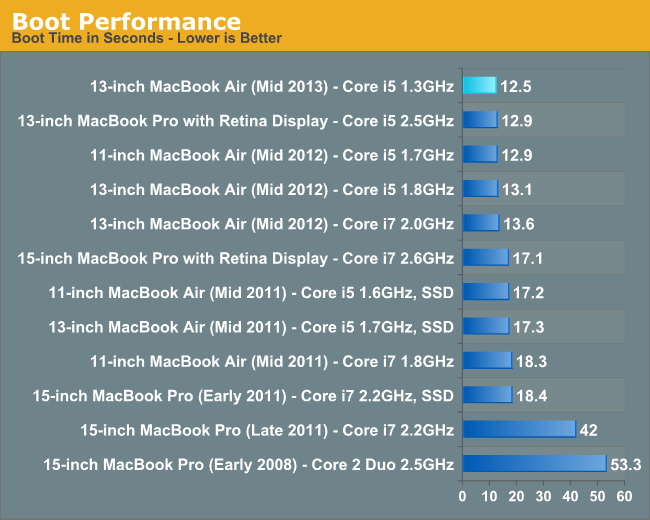
These next two charts look at single and multithreaded floating point performance using Cinebench 11.5. This test also gives us the rare opportunity of comparing to some older Mac Pro hardware as well from 2008 - 2010. Single threaded performance remains extremely important to overall system responsiveness, so it's always good to look at. As we found in our initial look at the new MBA, the 1.3GHz Core i5 CPU ends up performing about the same as last year's 1.8GHz part. I'd like to say it's all because of cooling and turbo boost, but in all likelihood Apple is trading some of Haswell's IPC gains for frequency here - enabling identical performance, at lower clocks thanks to Haswell's more efficient architecture.
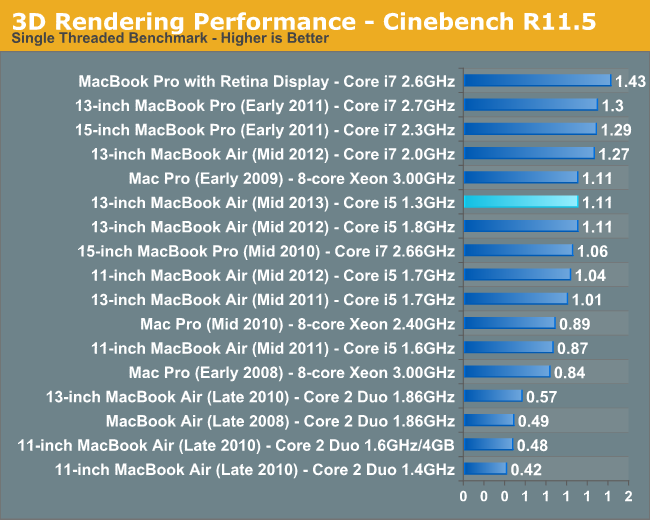
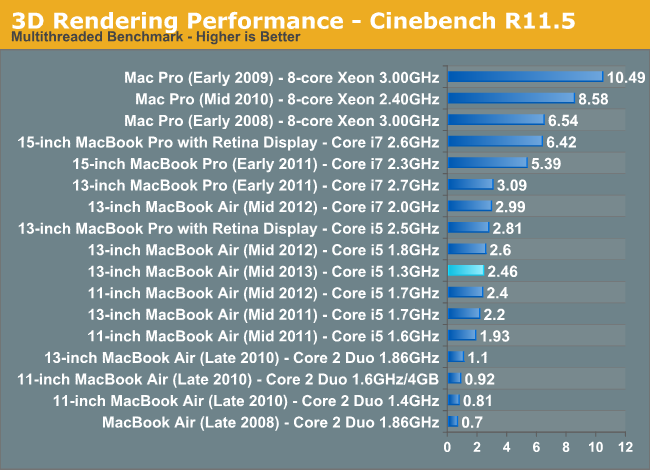
The multithreaded performance story is a bit different. The 1.3GHz i5 regresses in performance by about 5%. Overall performance is still quicker than the 2011 models, as well as the i7 based 11-inch MBA from 2012. Here we're simply seeing the 15W TDP limits come into play. Sharing both PCH and dual-core CPU power in a lower thermal footprint than last year's CPU alone is responsible for what we see above.
Video transcoding is really best suited for the higher end machines, but that doesn't change the fact that it's done on MacBook Airs as well. We'll start by looking at performance under iMovie. Here we're importing 1080p video from a Nikon D7000 and optimizing it during import.
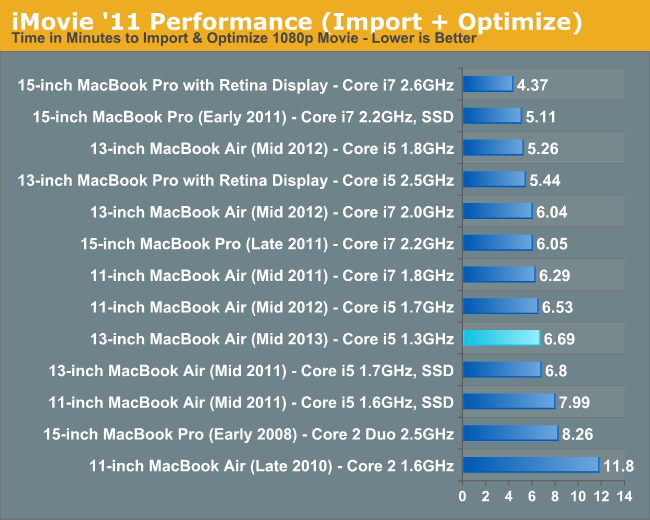
The 13-inch 1.3GHz Core i5 configuration performs similarly to last year's 11-inch 1.7GHz config. It's an interesting comparison because the 11-inch 2012 model is more thermally constrained than the 13-inch 2012 model, which is exactly what we see when we compare the 2013 13-inch MBA to the 2012 13-inch MBA. In this case the 2013 model is a hair quicker than the 2011.

We see a similar story for a full video export. The 1.3GHz 2013 MBA slots in behind the 2011 model in this CPU bound test.
Final Cut Pro X falls on the professional end of the video production spectrum. The test file is the same here, but the workload is far more strenuous.
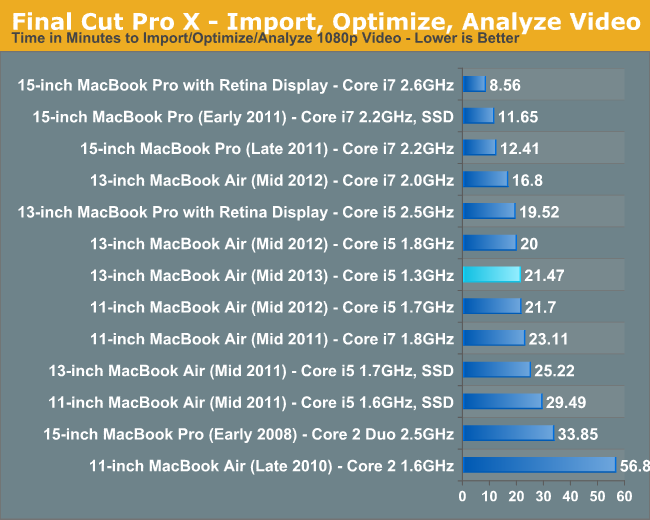
Once again, we see roughly the same performance from the 13-inch 2013 1.3GHz i5 as the 11-inch 2012 MBA. Here we do see substantially better performance than the 2011 models.
Our two photo workloads generally agree with what we saw in the video tests. The 1.3GHz Haswell part is definitely slower than th e previous generation 1.7/1.8GHz SKUs:
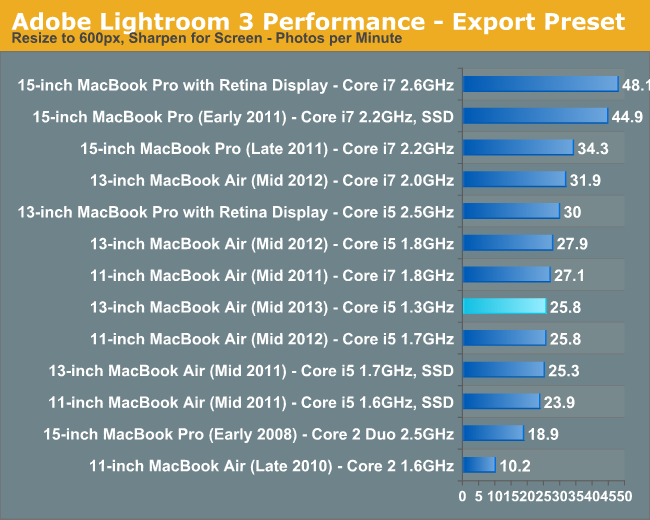
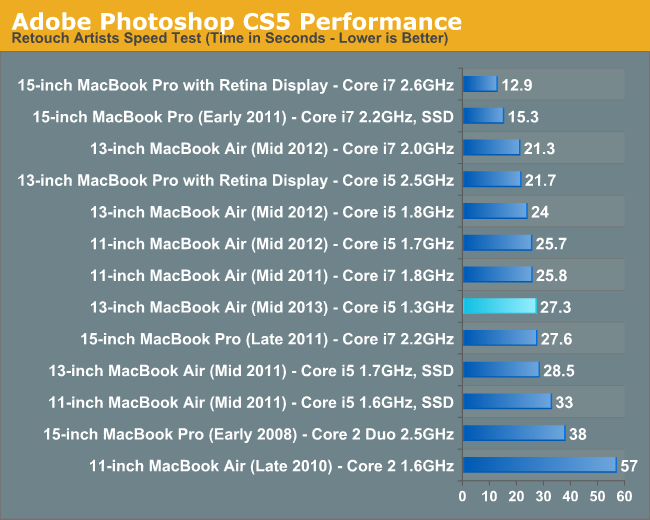
In our desktop review of Haswell I noted that performance in our compile test improved tremendously with the new architecture. As it's quite obvious that Haswell's IPC advantages don't surface all that much in our traditional suite, I wanted to see if perhaps things would be different in something that might lend itself better to Haswell's IPC improvements. I repeated our Firefox build test but under OS X. It's a multithreaded compile, with the number of threads set to 2x the number of cores (not threads) in a system. Unfortunately I came up with this bright idea while traveling, so I only had access to three machines: the 2013 13-inch MBA, the 15-inch rMBP and a 2GHz Core i7 2012 13-inch MBA. I'll add more results later, but I'm expecting this to be a part of our test suite going forward.

The combination of Haswell and a really fast SSD appears to help narrow the gap between the much higher clocked 2012 model and the base 2013 13-inch MBA. Here the faster Ivy Bridge CPU is less than 2% quicker. I'll reserve final judgements until I get my hands on the 1.7GHz Core i7 model, but my guess is this is an example of the best case scenario for Haswell where you get equivalent performance to a higher clocked Ivy Bridge part but with much better thermal/noise/battery life characteristics. For example, the fan was never audible on the 2013 MBA while running this test compared to running at a very noticeable volume on the 2012 Core i7 model. The same goes for temperatures. The i7 2012 model tends to run about 5% warmer along the bottom of the chassis compared to the 2013 i5.










233 Comments
View All Comments
doobydoo - Tuesday, June 25, 2013 - link
Sigh @ Ignorant people who compare processors of different architectures by GHz.TheinsanegamerN - Sunday, June 30, 2013 - link
the boost clocks are similar, and the haswell boosts way more than ivy bridge did. look at the cpu scores, which are similar, despite the 400 mhz reduction.Krysto - Monday, June 24, 2013 - link
Disappointing to see that even Apple has started being misleading about its battery life for laptops.It seems unlike Steve Jobs, Tim Cook is more of a "regular manager" who prefer spec lists and bullet points, over being truthful to customers. Now they're just lying about battery life numbers just as every other PC OEM out there - 12h of battery life! (but you might actually get only half of that).
And all that with a CPU that is 20 percent slower than last year, and a GPU that's twice as big but only 10-20 percent better than last year.
Also, the dual core Haswell chip alone costs $350? Yikes. So you still think these chips have any chance of competing in the tablet space, Anand? The whole of iPad Mini costs less than that, with a sub $30 chip. Intel is as behind as always when it comes to competing in the mobile space.
madmilk - Monday, June 24, 2013 - link
Sheesh, at least read the review. The battery life is 11 hours on the light workload, which is certainly more than half of the advertised 12. This difference is easily accounted for by the higher screen brightness and Flash. The 1.3GHz Haswell is not 20% slower either than the comparable 1.7GHz Ivy. More like 5% at worst, and in several cases faster. The GPU is 20% faster in a _much_ lower TDP, once the FIVR and PCH are accounted for, which contributes to the very impressive battery life on the heavy workload as well. As for Haswell pricing -- ULV i5/i7 are in another league compared to any ARM offering on the market. Atoms and Celerons are more appropriate for the toy tablet market.Sushisamurai - Tuesday, June 25, 2013 - link
... If you read the fine print on apple's website, they increased the benchmark demands on the MBA compared to previous battery tests just to make the 12 hrs seem more realistic. CNET and a few other sites posted their battery tests of the 13" to be rated for 14+ hours. I think anand already made a point about this...And if you compare ARM A9's & ARM A15's performance to intel's haswell platform... You would know ARM processors really can't compete on the same level. There's a reason for that price difference
lyeoh - Monday, June 24, 2013 - link
OK, so which review site is better? So that we can go read it as well...whyso - Monday, June 24, 2013 - link
You know what would be nice. GPU benchmarks for the rmbp 13" or HD 4000 from a standard voltage part to see how it compares to the HD 5000.tipoo - Monday, June 24, 2013 - link
Agreed. It can be confusing when the ULV parts have the same name as normal TDP parts and perform significanlty differently.tecsi - Monday, June 24, 2013 - link
Could these MBAs support external 4k displays given the Intel 5000? There appears to be a new Thunderbolt part—is this Thunderbolt 2? I am surmising that this support could be turned on in MBAs when the Mac Pro arrives with Mavericks, along with potentially Apple 4k displays.tipoo - Monday, June 24, 2013 - link
Not Thunderbolt 2. Only the new Mac Pro has that right now.